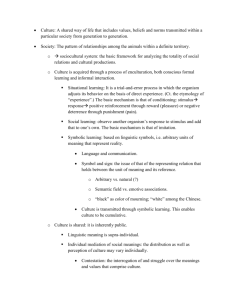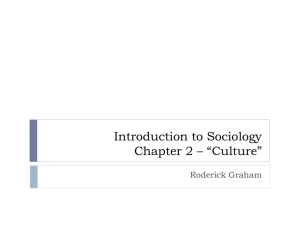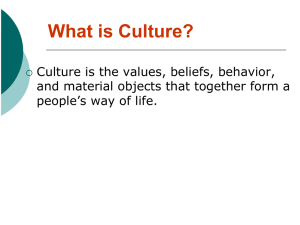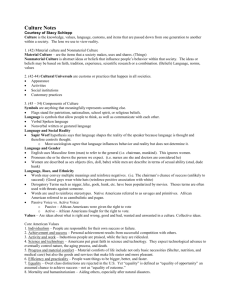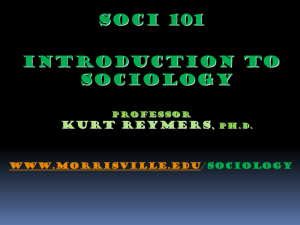Culture
advertisement
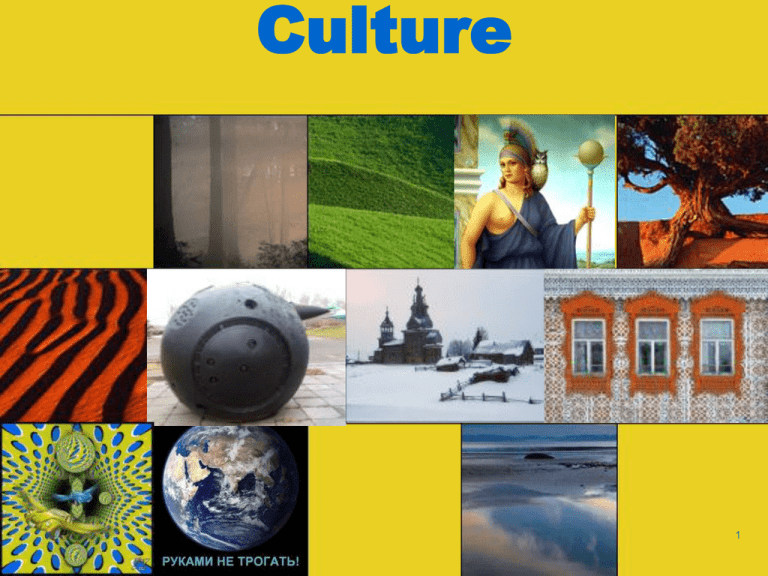
Culture 1 The Nature of Culture Culture A “personality” customized to a physical environment 2 Cultural Universals • confronting common problems – Eating/food – Shelter – Raising children – Common problems associated with daily living 3 Two Sides of a Coin • Culture – the way of life for a group of people • Society – the interaction of a group of people who share a particular culture – self-sufficient 4 Culture is Lens 5 6 7 Culture is taken-for-granted • Cultural shock • Ethnocentrism • Cultural Relativism • Culture provides the answers • Culture, a survival guide 8 Defining Culture Culture – all of the shared products of human group Includes both physical objects and the beliefs, values, and behaviors shared by a group • The “language, beliefs, values, norms, behaviors, and even material objects that are passed from one generation to the next” (Henslin 2007a:36). – A social heritage 9 Composition of culture – Material cultural products – Nonmaterial cultural products Material Culture – Formed by the physical objects that people create – – Cars, clothing, books, buildings, computers Archeologists refer to these items as artifacts Nonmaterial Culture – Abstract human creations (can’t touch it) – Language, family patterns, work practices, political and economic systems In Summary, so far… 11 Characteristics of Culture • • • • • • Culture is shared Culture if learned Culture is taken-for-granted Culture is symbolic Culture varies across time & place Culture is relative 12 Components of Culture • 1. Physical Objects • 2. Symbols • 3. Language • 4. Values • 5. Norms Components of Culture Physical Objects Physical Objects • Not only the “Physical” objects, but also the RULES for using those objects • Technology: The combination of objects AND rules. • *Also, tools used to manipulate the environment • Ex. Computer= Physical • Surfing the Web= Rules and skills related to COMPUTER Components of Culture SYMBOLS: • Anything that stands for (or shared meaning attached to it) something else • “something to which people attach meaning and that they then use to communicate with one another” (Henslin 2007a:39) • Any word, gesture, image, sound, physical object, event can serve as a symbol as long as people recognize that it carries a particular meaning • Ex. Class ring, word hello, handshake = all symbols • Symbols vary from culture to culture Components of Culture Symbols 17 Components of Culture Language – a complex system of symbols that can be combined any number of ways that represent not only material cultural products, but for communicating our nonmaterial cultural products as well – Organization of written or spoken symbols into a standardized system Sapir-Whorf hypothesis • Language shapes perceptions • Language leads people to think in particular ways 18 Components of Culture Beliefs&Values • Beliefs – The statements that people of a culture believe to be true • Values – Abstract concepts about the way society should be – Standards of judgment • Shared beliefs about what is good or bad, right or wrong, desirable or undesirable 19 Values Differ from culture to culture • Ex. Yanomamo: Brazil :Napoleon Chagnon… “Fierce People” • Warlike; Highly competitive • 30% of people die from war wounds • Communities usually break apart because of competition and never get larger than 200 people • Ex. San: Highly cooperative. Each family owns territory and does not “trespass” on each others soil • Most members share various vital roles in society Types of values held by a group determine the character of its people – A society that values war and displays of physical strength will be different from one that places more emphasis on sharing and cooperation Components of Culture Norms • Shared rules of conduct that tell people how to act in specific situations • Behavioral boundaries regulating social interactions • Norms are expectations, not actual behavior – doesn’t mean that actions of all individuals will be in line with norms. o Ex. Norm is to be financially responsible – some don’t pay bills • Lots of norms in society: unimportant (cover mouth when yawning) to very important (don’t kill anyone) • Some apply to everyone while some are specific o Ex. Nobody in US is allowed to marry more than one person. Selected groups (some clergy and children) are not allowed to marry at 21 all Components of Culture Types of Norms Types of Norms Folkways Mores Laws Informal rules guiding everyday behavior Behaviors essential for society Formal rules guiding behavior Ex. Eating salad with a spoon “Abnormal; not illegal” Has the potential to become a dysfunction of society Are usually enforced by Laws Written rule of conduct enacted and enforced for good of society Ex. Killing someone 22 Building Blocks of Culture and Society beliefs norms values STATUSES Social Interaction ROLES Symbols LANAGUAGE 23 Heredity –transmission of genetic characteristics from parents to children. Environment –social and cultural conditions that influence the life of an individual or community Role – behavior – the rights and obligations – expected of someone occupying a particular status Assimilation – blending of culturally distinct groups into a single group with a common culture and identity Stereotype – oversimplified, exaggerated, or unfavorable generalization about a category of people Prejudice – unsupported generalization about a category of people Discrimination – denial of equal treatment to individuals based on their group membership ‘Discriminations prevents someone from sharing their ‘gifts’ with another person.’ Nature vs. Nurture Culture - Terms • • • • • • • • Heredity –transmission of genetic characteristics from parents to children. Environment –social and cultural conditions that influence the life of an individual or community Role – behavior – the rights and obligations – expected of someone occupying a particular status Assimilation – blending of culturally distinct groups into a single group with a common culture and identity Stereotype – oversimplified, exaggerated, or unfavorable generalization about a category of people Prejudice – unsupported generalization about a category of people Discrimination – denial of equal treatment to individuals based on their group membership ‘Discriminations prevents someone from sharing their ‘gifts’ with another person.’ 25 Three Levels of Culture • Culture Trait: Individual tool, act, or belief that is related to a certain situation (Spoon, Baseball..etc) • Culture Complex: Cluster of interrelated traits (Silverware, Baseball Equipment…etc) • Culture Pattern: Combination of culture complexes (Sports…not just baseball…etc) Cultural Diversity • A “social mosaic of people from different racial and ethnic backgrounds, nationalities, religions, and cultures” (Thompson and Hickey 2005:6) • The “spice” of society (instructor’s view) 27 Cultural Diversity con’t Cultural Diffusion Cultural Leveling 28 Cultural Diversity con’t • Subcultures • Countercultures 29 Cultural Diversity con’t • “Ideal” verses “Real” Culture – Cultural Lag – Technology 30 Theoretical Perspectives on Culture • Functionalism – Cultural ecological approach – Durkheim’s collective consciousness • Conflict – Stresses the importance of power and coercion in cultural evolution (Inciardi and Rothman 1990:77) – Focus on social tension created by competing cultures, and subcultures • Symbolic Interactionism – Micro level aspect of culture – How culture is generated, sustained, and changed in a society by people and not social institutions (Renzetti and Curran 1998:75) 31 Theoretical Perspectives on Culture con’t • In summary… – Functionalism & Conflict—culture constrains human behavior – Symbolic Interactionism—culture is a human creation 32


